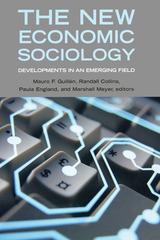2 books about England, Paula

The New Economic Sociology
Developments in an Emerging Field
Maruo F. Guillen
Russell Sage Foundation, 2002
As the American economy surged in the 1990s, economic sociology made great strides as well. Economists and sociologists worked across disciplinary boundaries to study the booming market as both a product and a producer of culture, tracing the correlations they saw between economic and social phenomena. In the process, they debated the methodological issues that arose from their interdisciplinary perspectives. The New Economic Sociology provides an overview of these debates and assesses the state of the burgeoning discipline. The contributors summarize economic sociology's accomplishments to date, identifying key theoretical problems and opportunities, and formulating strategies for future research in the field. The book opens with an introduction to the main debates and conceptual approaches in economic sociology. Contributor Neil Fligstein suggests that the current resurgence of interest in economic sociology is due to the way it brings together many sociological subdisciplines including the study of markets, households, labor markets, stratification, networks, and culture. Other contributors examine the role of economic phenomena from a network perspective. Ron Burt, for example, demonstrates how social relationships affect competitive dynamics in the marketplace. A third set of chapters addresses the role of gender in economic sociology. In her chapter, Barbara Reskin rethinks conventional notions about discrimination and points out that the law only covers one type of discrimination, while in recent years social scientists have uncovered other forms of hidden discrimination, which must be addressed as well. The New Economic Sociology also addresses the problem of economic development and change from a sociological perspective. Alejandro Portes and Margarita Mooney elaborate on one of the key emerging concepts in economic sociology, arguing that social capital—as an attribute of communities and regions—can contribute to economic and social well-being by fostering collaboration and entrepreneurship. The contributors concur that economic action must be interpreted through the cultural understandings that lend it stability and meaning. By rendering these often complex debates accessible, The New Economic Sociology makes a significant contribution to this still rapidly developing field, and provides a useful guide for future avenues of research.
[more]

Unmarried Couples with Children
Paula England
Russell Sage Foundation, 2007
Today, a third of American children are born outside of marriage, up from one child in twenty in the 1950s, and rates are even higher among low-income Americans. Many herald this trend as one of the most troubling of our time. But the decline in marriage does not necessarily signal the demise of the two parent family—over 80 percent of unmarried couples are still romantically involved when their child is born and nearly half are living together. Most claim they plan to marry eventually. Yet half have broken up by their child's third birthday. What keeps some couples together and what tears others apart? After a breakup, how do fathers so often disappear from their children's lives? An intimate portrait of the challenges of partnering and parenting in these families, Unmarried Couples with Children presents a variety of unique findings. Most of the pregnancies were not explicitly planned, but some couples feel having a child is the natural course of a serious relationship. Many of the parents are living with their child plus the mother's child from a previous relationship. When the father also has children from a previous relationship, his visits to see them at their mother's house often cause his current partner to be jealous. Breakups are more often driven by sexual infidelity or conflict than economic problems. After couples break up, many fathers complain they are shut out, especially when the mother has a new partner. For their part, mothers claim to limit dads' access to their children because of their involvement with crime, drugs, or other dangers. For couples living together with their child several years after the birth, marriage remains an aspiration, but something couples are resolutely unwilling to enter without the financial stability they see as a sine qua non of marriage. They also hold marriage to a high relational standard, and not enough emotional attention from their partners is women's number one complaint. Unmarried Couples with Children is a landmark study of the family lives of nearly fifty American children born outside of a marital union at the dawn of the twenty-first century. Based on personal narratives gathered from both mothers and fathers over the first four years of their children's lives, and told partly in the couples' own words, the story begins before the child is conceived, takes the reader through the tumultuous months of pregnancy to the moment of birth, and on through the child's fourth birthday. It captures in rich detail the complex relationship dynamics and powerful social forces that derail the plans of so many unmarried parents. The volume injects some much-needed reality into the national discussion about family values, and reveals that the issues are more complex than our political discourse suggests.
[more]
READERS
Browse our collection.
PUBLISHERS
See BiblioVault's publisher services.
STUDENT SERVICES
Files for college accessibility offices.
UChicago Accessibility Resources
home | accessibility | search | about | contact us
BiblioVault ® 2001 - 2024
The University of Chicago Press









